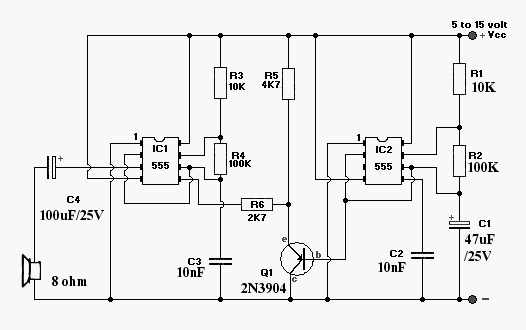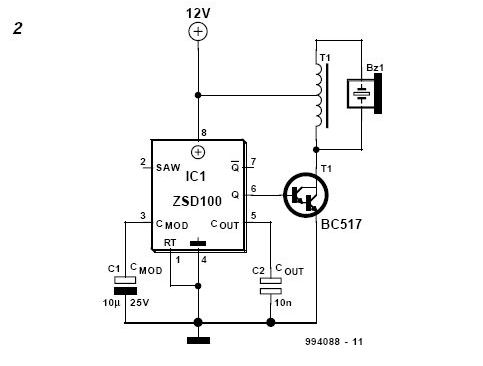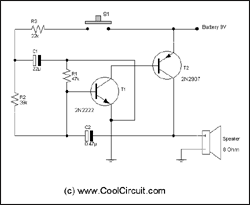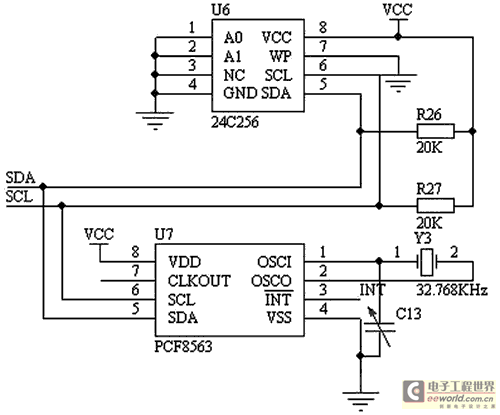
electronically designed siren
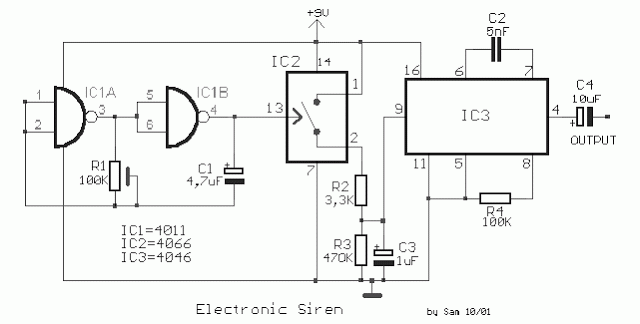
The circuit was designed to create an electronic siren to produce an alert sound in emergency situations or any circumstances that require its usage. The 4011 is a quad 2-input NAND gate integrated circuit, characterized by minimal voltage supply fluctuations, very high impedance, and outputs that can both sink and source. It can drive up to 50 inputs, has a high-speed gate propagation time, operates at high frequencies, and consumes low power. The 4066 is a digitally controlled quad analog switch utilizing advanced silicon-gate CMOS technology, featuring individual switch controls, matched switch characteristics, pin and function compatibility, low quiescent current, low ON resistance, a wide analog input voltage range, and a typical switch enable time of 15 ns. The 4046 is a phase-locked loop CMOS logic IC used in applications such as motor speed control, FSK modulation, tone decoding, voltage-to-frequency conversion, data conditioning and synchronization, frequency discrimination, frequency multiplication and synthesis, and FM modulation and demodulation. It is notable for its high VCO linearity, low frequency drift, low dynamic power consumption, and wide supply voltage range. The circuit consists of oscillators IC1a and IC1b, which are composed of two NAND gates. These logic gates produce a HIGH output when one or both inputs are LOW, generating low-frequency oscillation that drives the analog electronic switch. The switch operates by opening and closing in accordance with the oscillation pattern. When the switch is closed, the voltage supply charges capacitor C3 through resistor R2, while C3 discharges through resistor R3 when the switch is open. The voltage across capacitor C3 regulates the VCO of IC3, a phase-locked loop logic IC, allowing one output to be a modified audio signal. The siren's sound can be altered by changing the values of the resistors and capacitors, requiring some experimentation for sound adjustment. The duration and operational time are determined by the combination of R1 and C1, while the frequency of the produced sound is managed by the combination of R4 and C2. The sound variation is controlled by the combination of R3 and C3. The electronic siren system is ideally suited for warning equipment in police vehicles, including cars and motorcycles, ambulances, fire trucks, and other emergency vehicles. When installed in stationary locations, it is effective for security and protection, home alarms, water alarms, and public alert systems, providing alarming sounds for municipalities and cities, as well as in establishments such as plants and factories with potentially hazardous materials. They are also utilized in open spaces, halls, and arenas. The most critical feature they provide is their functionality in emergency situations, serving as large warning systems. When selecting an electronic siren, factors such as lightweight design, high-intensity shell, high reliability, and quality craftsmanship should be considered.
The electronic siren circuit employs a combination of integrated circuits and passive components to achieve its functionality. The primary component, the 4011 NAND gate, is responsible for generating oscillations that modulate the signal driving the siren. The IC operates efficiently with low power consumption, making it suitable for battery-operated devices. The 4066 analog switch allows for precise control of the audio output, enabling the siren to produce different tones and patterns based on the control signals received from the oscillators.
The design integrates capacitors and resistors strategically to form timing circuits that dictate the frequency and duration of the sound produced. The relationship between these components is critical; for instance, increasing the resistance or capacitance values can lower the frequency of oscillation, resulting in a deeper sound, while decreasing them raises the frequency, creating a higher-pitched alert. This flexibility is essential for tailoring the siren's output to specific requirements, whether for emergency vehicles or stationary alarm systems.
The versatility of the electronic siren makes it applicable in various scenarios, from enhancing the safety of emergency responders to providing alerts in industrial settings. The ability to modify sound characteristics through component adjustments allows for customization to meet specific regulatory or operational needs. Overall, the circuit's design emphasizes reliability and adaptability, ensuring effective performance across a wide range of applications.The circuit was designed to create an electronic siren to provide a scheme for producing an alert sound in emergency cases or any circumstances that requires its usage. 4011 a quad 2-input NAND gate integrated circuit, generally characterized by small fluctuation in voltage supply, very high impedance, outputs that can sink and source, one out
put can drive up to 50 inputs, high speed gate propagation time, high frequency, and low power consumption. 4066 a digitally controlled quad analog switch utilizing advanced silicon-gate CMOS technology with features such as individual switch controls, matched switch characteristics, pin and function compatibility, low quiescent current, low ON resistance, wide analog input voltage range, and 15 ns typical switch enable time.
4046 a phase locked loop CMOS logic IC used in motor speed control, FSK modulation, tone decoding, voltage-to-frequency conversion, data conditioning and synchronization, frequency discrimination, frequency multiplication and synthesis, and FM modulator and demodulator, due to its high VCO linearity, low frequency drift, low dynamic power consumption, and wide supply voltage range. The circuit consists of oscillators IC1a and IC1b which are made up of two NAND gates. These are logic gates which produce HIGH output in the event of one or both inputs being LOW. They are responsible for low frequency oscillation which drives the analog electronic switch. The switch operates by opening and closing with the sequence and pattern of oscillation. The supply of the voltage will charge the capacitor C3 via the resistor R2 when the switch is closed while C3 discharges through the resistor R3 when the switch is open.
The voltage used by capacitor C3 is used to regulate the VCO of IC3 which is a phase-locked loop logic IC. This enables one output to be a modified audio. The sound of the siren can be altered by changing the values of the resistors and capacitors that will include some experimentation to adjust the sound.
The duration and time of operation of operation is determined by the combination of R1 and C1 while the frequency of the produced sound is handled by the combination of R4 and C2. Lastly, the changing of sound is controlled the R3 and C3 combination. The electronic siren system is ideally used in warning equipments in the field of police vehicles such as cars and motorcycles, ambulances, fire trucks or engines, and other types of emergency vehicles.
When used on stationary places, there are more effective in security & protection, home alarm, water alarm, and public alert systems which provide alarming sound to municipalities and cities, in establishments like plants, factories and locations with potentially dangerous materials. They are also utilized in open spaces, halls and arenas. The most important feature that they provide is in cases of emergency situations in which they are being used for large warning systems.
In choosing an electronic siren, the features such as light weight, high intensity shell, high reliability, and good quality with excellent workmanship, should be considered. 🔗 External reference
The electronic siren circuit employs a combination of integrated circuits and passive components to achieve its functionality. The primary component, the 4011 NAND gate, is responsible for generating oscillations that modulate the signal driving the siren. The IC operates efficiently with low power consumption, making it suitable for battery-operated devices. The 4066 analog switch allows for precise control of the audio output, enabling the siren to produce different tones and patterns based on the control signals received from the oscillators.
The design integrates capacitors and resistors strategically to form timing circuits that dictate the frequency and duration of the sound produced. The relationship between these components is critical; for instance, increasing the resistance or capacitance values can lower the frequency of oscillation, resulting in a deeper sound, while decreasing them raises the frequency, creating a higher-pitched alert. This flexibility is essential for tailoring the siren's output to specific requirements, whether for emergency vehicles or stationary alarm systems.
The versatility of the electronic siren makes it applicable in various scenarios, from enhancing the safety of emergency responders to providing alerts in industrial settings. The ability to modify sound characteristics through component adjustments allows for customization to meet specific regulatory or operational needs. Overall, the circuit's design emphasizes reliability and adaptability, ensuring effective performance across a wide range of applications.The circuit was designed to create an electronic siren to provide a scheme for producing an alert sound in emergency cases or any circumstances that requires its usage. 4011 a quad 2-input NAND gate integrated circuit, generally characterized by small fluctuation in voltage supply, very high impedance, outputs that can sink and source, one out
put can drive up to 50 inputs, high speed gate propagation time, high frequency, and low power consumption. 4066 a digitally controlled quad analog switch utilizing advanced silicon-gate CMOS technology with features such as individual switch controls, matched switch characteristics, pin and function compatibility, low quiescent current, low ON resistance, wide analog input voltage range, and 15 ns typical switch enable time.
4046 a phase locked loop CMOS logic IC used in motor speed control, FSK modulation, tone decoding, voltage-to-frequency conversion, data conditioning and synchronization, frequency discrimination, frequency multiplication and synthesis, and FM modulator and demodulator, due to its high VCO linearity, low frequency drift, low dynamic power consumption, and wide supply voltage range. The circuit consists of oscillators IC1a and IC1b which are made up of two NAND gates. These are logic gates which produce HIGH output in the event of one or both inputs being LOW. They are responsible for low frequency oscillation which drives the analog electronic switch. The switch operates by opening and closing with the sequence and pattern of oscillation. The supply of the voltage will charge the capacitor C3 via the resistor R2 when the switch is closed while C3 discharges through the resistor R3 when the switch is open.
The voltage used by capacitor C3 is used to regulate the VCO of IC3 which is a phase-locked loop logic IC. This enables one output to be a modified audio. The sound of the siren can be altered by changing the values of the resistors and capacitors that will include some experimentation to adjust the sound.
The duration and time of operation of operation is determined by the combination of R1 and C1 while the frequency of the produced sound is handled by the combination of R4 and C2. Lastly, the changing of sound is controlled the R3 and C3 combination. The electronic siren system is ideally used in warning equipments in the field of police vehicles such as cars and motorcycles, ambulances, fire trucks or engines, and other types of emergency vehicles.
When used on stationary places, there are more effective in security & protection, home alarm, water alarm, and public alert systems which provide alarming sound to municipalities and cities, in establishments like plants, factories and locations with potentially dangerous materials. They are also utilized in open spaces, halls and arenas. The most important feature that they provide is in cases of emergency situations in which they are being used for large warning systems.
In choosing an electronic siren, the features such as light weight, high intensity shell, high reliability, and good quality with excellent workmanship, should be considered. 🔗 External reference
